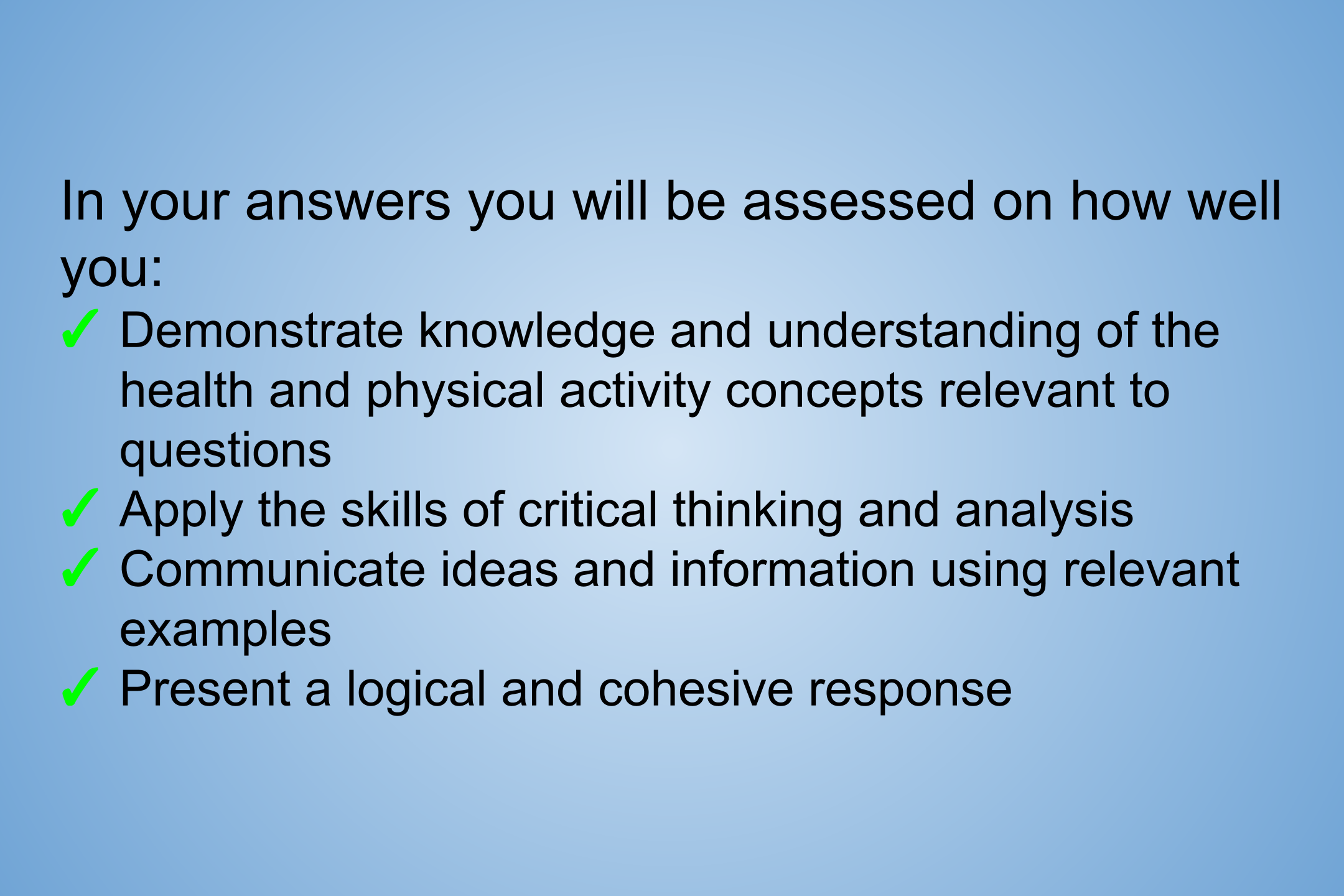The HSC PDHPE marking rubric refers to the 4 dot points above the extended response questions:
- Demonstrate knowledge and understanding of the health and physical activity concepts relevant to questions
This criteria basically means that you show the correct interpretation of the question by doing what the directive term states (compare, analyse, describe) while using the correct syllabus content.
- Apply the skills of critical thinking and analysis
Throughout your answer, you should ensure that you have gon into considerable depth and asked questions of current knowledge, giving information for both sides, or future possibilities. Look for directive terms such as: analyse, judge, discuss, compare, justify, evaluate or assess along with the word critically to help guide what you need to do here.
- Communicate ideas and information using relevant examples
In pretty much all HSC exam answers that you write you should be showing your knowledge through examples that support and connect with your answer. You should not just list them at the end, but instead, seek to weave them into your answer at relevant places to add further weight to your arguments or to demonstrate certain concepts in action. They should be concise, specific and relevant.
- Present a logical and cohesive response
This means that your answer flows well and clearly addresses the question being asked. Using the SEAL structure and planning your answer will help to ensure that your answer is logical and cohesive.
Let’s take a look at a 12 mark questions from the 2012 exam. Please note that I have colour coded the answer to match the criteria above. This is a great exercise for you to do regularly to ensure you develop your ability to create well-written answers.
Question 32 (b)
Evaluate the risks and ethical issues related to the use of drugs to improve performance. (12 marks)
Performance-enhancing drugs can pose health, financial and social risks and also create an unequal playing field for athletes. Testing athletes for drugs will assist in preventing or deterring drug cheats and improve competition so that performances are due to training and genes rather than steroids.
There are dangers associated with use of performance-enhancing drugs. The dangers can be physical effects such as heart disease or loss of reputation and sponsorship if caught using drugs. For example, when Marion Jones got in trouble for using drugs, she lost her reputation for being a great athlete due to hard training and dedication. Drugs also increase the risk of cancer and heart disease. For these reasons athletes should be drug tested to reduce the risk of athletes using drugs to enhance performance and consequently do irreversible damage to their health.
Drug use for strength can have many negative effects on health. Anabolic steroids can lead to liver disease and increase the risk of heart disease. If an athlete is using drugs to enhance their performance they may have an unfair advantage, but they are also harming themselves. For example, if a weightlifter uses steroids they will be able to train harder and longer and get stronger faster. This could lead to shortening of their life (eg heart attack). Plus this is unfair and creates an uneven playing field along with long-term health effects. Drug testing is important as it will intimidate the athletes from using drugs since they will be banned if found using drugs.
Drugs are sometimes used by endurance athletes to enhance performance. For example, last year a cyclist was caught using EPO in the Tour de France. EPO improves aerobic ability and allows an athlete to cycle harder for longer. This makes the race unfair for the non-drug users and can reduce future sponsorship and sport development opportunities. EPO can cause heart attack, stroke and blood clots. Drug testing catches the athletes that cheat and deters them from taking the risk that also harms their health.
Some athletes use drugs such as diuretics, alcohol. These drugs are more commonly used to mask the use of other drugs. The health problems associated with using diuretics are kidney damage and dehydration. These drugs can also improve performance in those sports with weight classes. For example, before a 24-hour weigh-in for boxing, the boxer may use diuretics to make a lighter weight class and then rehydrate to be a heavier weight before the fight against a lighter opponent. Drug testing for diuretics helps reduce the risk of athletes cheating in weight classes and having unfair advantage. Large amounts of money are associated with sports like boxing through endorsements and gambling. The unfair environment created by drug use can create larger social harm because people bet on athletes without knowing whether drugs are used or not. Testing reduces the risk of competitors using and promoting good health above the desire to win at all costs.
Drug testing deters athletes from using drugs. When those athletes using drugs are disqualified, competition becomes fair. However, drug testing is always behind the development of new drugs used to cheat in sports and so may never eradicate drug use from sport.
PDHPE HSC Sample Answers 2012 (final red sentence my addition)
Clearly, this sample answer is well written and addresses the criteria. Each of the main paragraphs addresses all four (4) of the criteria and includes a short introduction and conclusion (which while not necessary in PDHPE, can be useful)
The final paragraph really helps to drive home critical thinking and the logical cohesive nature of the sample answer as it links the whole answer to the question. The final bit in red, that I added to the sample answer provided by NESA, helps to show how critical thinking can be included in your answer as it shows a limitation of drug testing in relation to ethical issues in sport.
I want to encourage you to do this process at least once or twice a week.
- Read through a past exam sample answer provided by NESA
- Use the marking criteria to highlight different sections different colours (notice how there are no wasted words in this answer that do not address the criteria, this should be one of your goals with writing)
- Then, put the sample answer away, read the question and create your own answer to the question.






